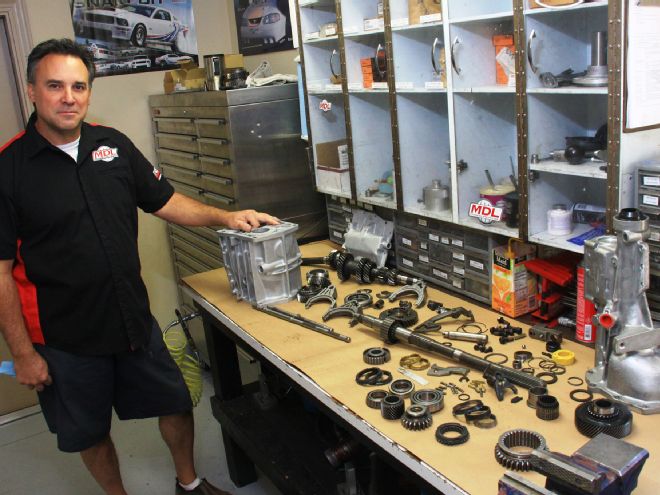
One of the most popular drivetrain mods done to early Mustangs is to swap out the non-overdriven three- and four-speed transmissions with the later-model overdrive T-5 five-speed. Not only does the T-5 provide a highway-friendly overdrive, but it also provides a deep First gear ratio for better off-the-line performance. The Mustang’s T-5 five-speed transmission has been in continuous production for 34 years. Originally designed and manufactured by Borg-Warner and first offered in the Mustang in 1983, the venerable T-5 has been a Pony Car mainstay for longer than a lot of us have been licensed drivers. The fully synchronized T-5 transmission is a countershaft-style helical gear unit. In the late ’90s, Borg-Warner sold its manual transmission division to Tremec, which is still building new T-5 transmissions to this day—they are available from Modern Driveline along with all of the parts necessary to service them.
We’re not going to show you step-by-step how to rebuild a World Class T-5, but instead provide you with basic information to help get you started on your five-speed adventure. Great technical information and service are available from Bruce Couture and Paul Coffey at Modern Driveline. Because these gentlemen have been working with the T-5 for decades, they understand its design and nature better than anyone in the industry, and are willing to share that knowledge with all of us.
The T-5 wasn’t a totally new transmission when it was introduced in the early ’80s. It was an evolution of the ’70s vintage Borg-Warner SR4 four-speed, which later became the T-4 five-speed manual box. Chevy was the first to use the T-5 as a factory-installed transmission in sport utilities and trucks. American Motors was yet another automaker to employ the T-5 early in the going.
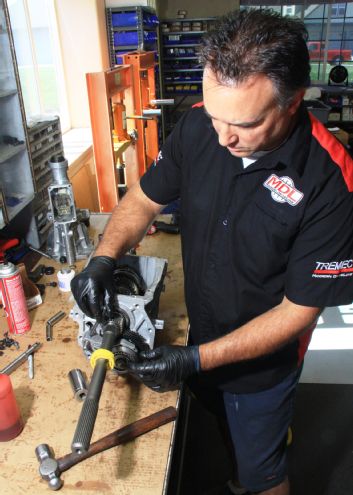
Mid-year 1983, Ford introduced five-speed shifting in the Mustang for improved fuel economy and snappy performance. It really was a remarkable development for Mustang buyers. Ditto for Chevrolet with the Camaro and Pontiac with Firebird. Other automakers quickly caught on to what the T-5 did for fuel economy and performance, which means you can expect to find many variations of the T-5 box in your search. There are more than 260 variations of the T-5 out there. Our goal is to help you find the right one for your Mustang.
There are two basic types of T-5 transmissions—the original T-5 STD (Non-World Class or NWC) and the World Class T-5 (WC). When manufacturers started ramping up power in the mid ’80s, Borg-Warner conceived and manufactured a better T-5 that could manage the kind of power Detroit was building into its performance vehicles. When Ford went to a more powerful 5.0L High Output engine in 1985, it got the World Class T-5 with durability built into its redesign.
Bruce Couture of Modern Driveline tells Mustang Monthly the “World Class” name had little to do with strength and durability, but instead the T-5’s introduction into the world market in the mid ’80s as an improved performance transmission. More by coincidence the T-5 World Class was an improved design engineered to take greater amounts of power and deliver improved shift quality. Couture adds that World Class T-5 improvements included revised synchronizers and bearings, which makes the World Class easy to identify. If you examine the front of the World Class main case, you will see the difference in countershaft bearings. The World Class has a Timken tapered race bearing cup, easily seen from the front of the main case.
Couture tells us, “Borg-Warner also provided many other non–World Class gear ratios. Most were geared down to allow a small displacement engine to rev easily through the gears. To do this the First gear ratios were in the range of 3.75 to 4.10:1. All the main shaft gears, First through Third, ride on a solid output shaft with deep oil grooves to provide good lubrication.” He goes on to say, “The lower countershaft gears spin on straight cylindrical bearings with a thrust washer in front to provide support when under load. All the synchronizer rings are made of solid bronze, which are of different size than those found in a World Class T-5 because there is no bearing under each gear and the bronze synchronizer rings that the non-World Class T-5 use the heavier Dextron II fluid.
“Since Dextron II is no longer available, engineers at Tremec now recommend using straight 50W gear oil in the older non–World Class T-5. The lighter Dextron III weight can be used but may adversely effect shifting and wear. Torque rating for the 2.95:1 NWC T-5 was 265 lb-ft. Four-cylinder ratios are much lower as a result of the tooth count between gears,” Couture tells Mustang Monthly.
Couture tells us Ford also used the T-5 in 2.3L four-cylinder cars through the years. While the four-cylinder T-5 may appear to be the same externally as the V-6 and V-8 versions, they are not the same box. Most four-cylinder T-5 transmissions received a 3.97:1 gear set with a 0.79 overdrive and smaller input pilot bearing shaft. A four-cylinder T-5 should never be used behind a V-8, even when the pilot bearing’s inside diameter is decreased to match shaft pilot size. These smaller input shafts will not hold up to the added torque and provide too low of a First gear ratio. Torque rating is just 240 lb-ft.
Ford was among the first Detroit automakers to use the new World Class T-5 transmission in 1985. “The 5.0L V-8 received a 3.35:1 First gear set with a 0.68 overdrive while the 2.3L four got a 3.97:1 First gear and an 0.79 overdrive. The main reason for the 3.35:1 First gear behind the 5.0L High Output V-8 was to give the small-block added snap with 2.73:1 or optional 3.08:1 rear axle gears.” Couture adds, “The 1986 Mustang SVO received a one-year-only 3.50:1 First gear ratio because the 3.97:1 was too low for the added power of the turbocharged 2.3L four.” The World Class T-5 sported an improved torque rating of 265 lb-ft.
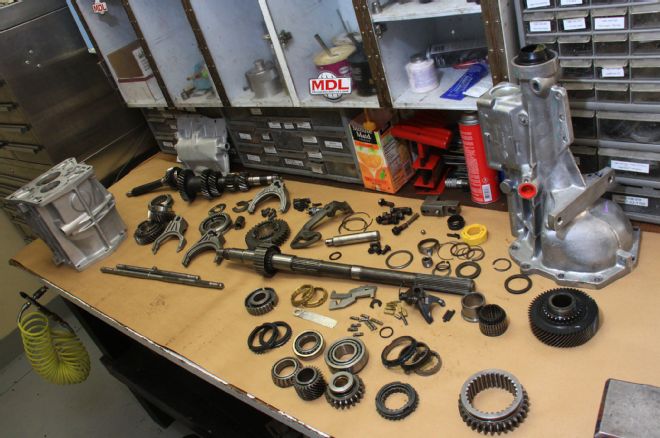
01. Here’s a World Class T-5 transmission laid out across the service bench at Modern Driveline. Paul Coffey, who is chief customer service engineer at Modern Driveline, has a very methodical approach to each T-5 he builds. He closely examines every part to ensure that it’s going to operate properly when it arrives on the customer’s doorstep.
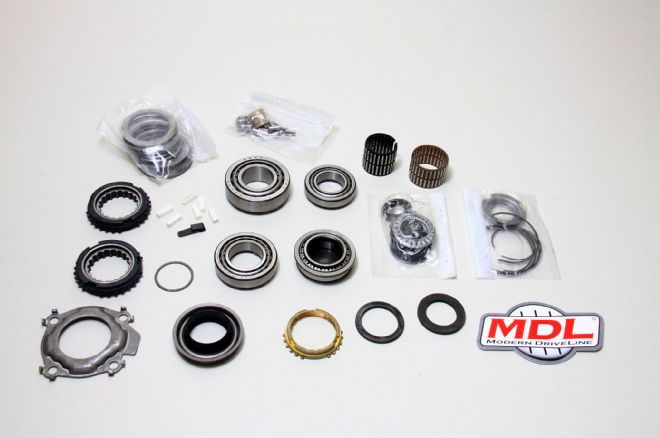
02. This is a World Class T-5 rebuild kit available from Modern Driveline, which includes nearly everything you’re going to need to rebuild a World Class T-5 with the exception being any broken hard parts you’re going to have to replace.
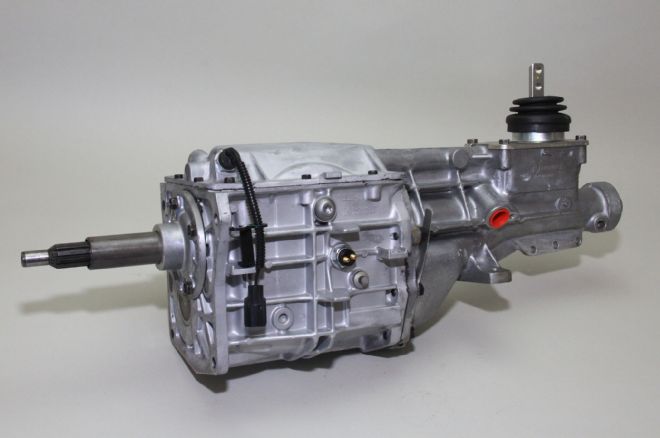
03. This is the World Class T-5 five-speed transmission as most of us know it. This one is a mid-’90s Borg-Warner main case and extension housing, which hasn’t changed much since the World Class was introduced in 1985. A variety of extension housings have been used, depending upon application. This T-5 is a slam-dunk fit for classic and late-model Fox-body Mustangs.
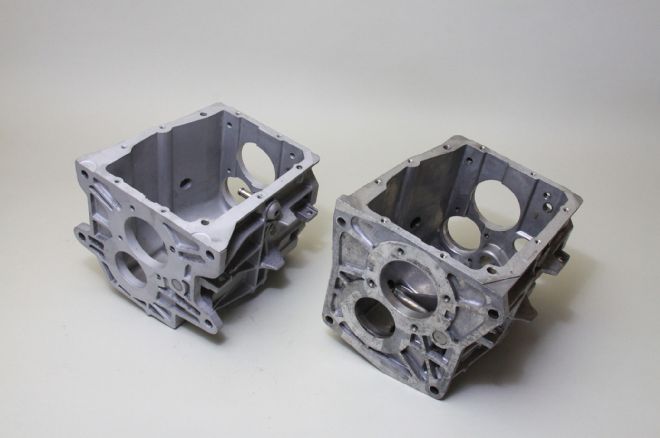
04. Here are two T-5 main cases. On the left is a GM main case with the wide bolt pattern. On the right is Ford. The GM T-5 main case has the same wide bellhousing bolt pattern as the classic Muncie four-speed transmission found in older GM muscle cars.
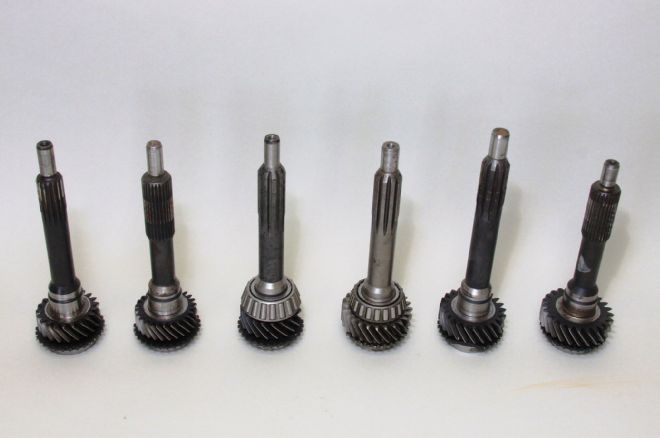
05. From left to right are the six T-5 input shafts—Chevy S-10 14-spline, Chevy S-10 26-spline, 2.3L four-cylinder Mustang 10-spline, 3.8L and 5.0L Mustang 10-spline, 3.8L and 5.0L 10-spline 1994-2004 Mustang, and the Camaro 26-spline. The 1994-2004 input shaft is longer due to shifter placement in the SN-95 Mustang, which calls for a specific bellhousing that is deeper to move the transmission aft.
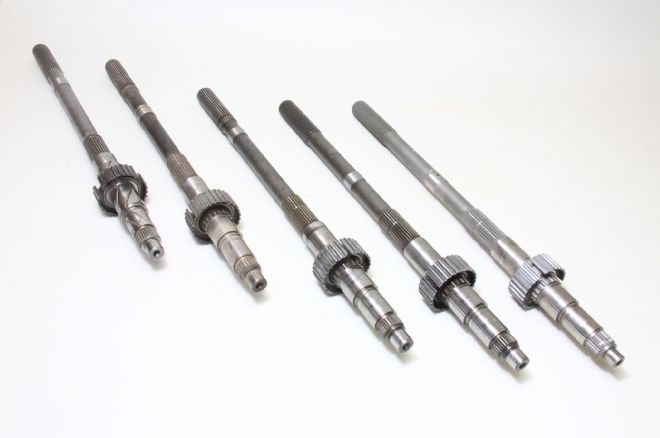
06. Here are five T-5 output shafts from left to right: typical non-World Class, S-10 27-spline World Class, Camaro 27-spline World Class, Mustang 28-spline World Class, and the SVT Mustang Cobra/T-5Z 28-spline.
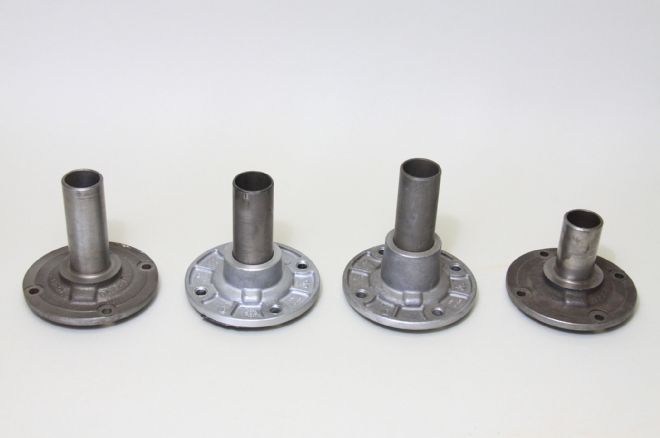
07. Shown here are four T-5 front bearing retainers from left to right: S-10 (iron/steel), 1983-1993 Mustang, 1994-2004 Mustang, and Camaro. Note the longer clutch release sleeve on the SN-95 to accommodate the deeper bell.
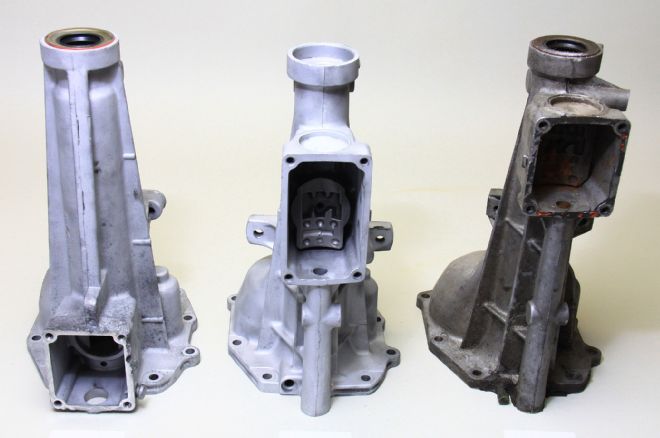
08. Here are three of the most common T-5 extension housings from left—S-10, Mustang, and Camaro. When you study shifter placement, it becomes obvious why you could not use the S-10 or Camaro extensions in a Mustang.
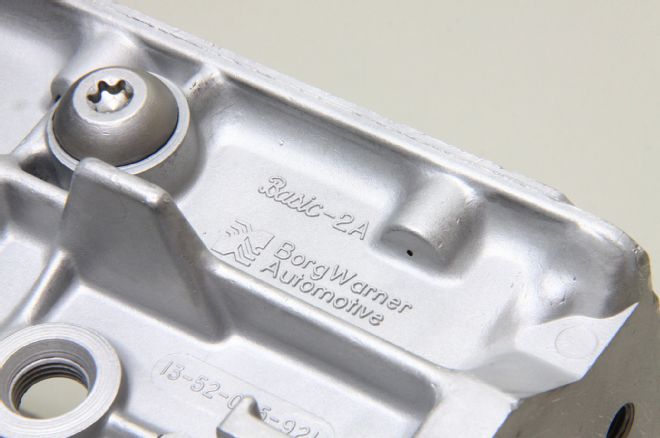
09. The Tremec and Borg-Warner castings are basically the same with the exception being the name on the casting. Non-World Class and World Class main cases are different and have to be treated as such.
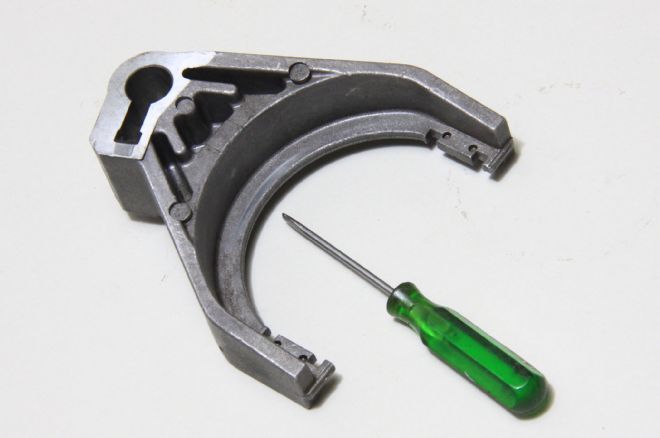
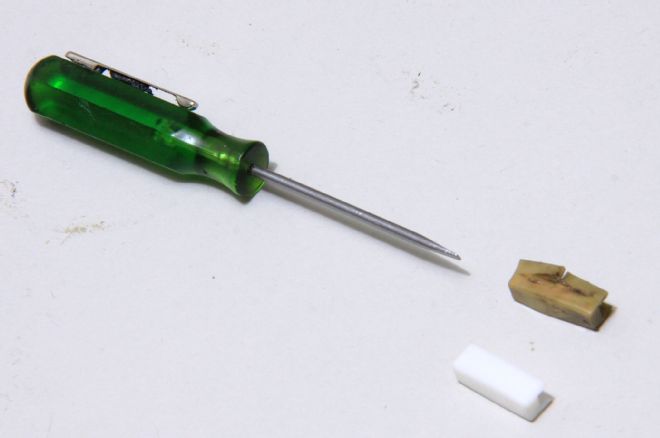
10-11.. Modern Driveline’s Paul Coffey stresses close inspection of critical items like shifter forks. Excessive fork and fork insert pad wear is unacceptable and cause for rejection, Coffey tells Mustang Monthly. Every rebuild should include new fork insert pads, which are included in the Modern Driveline kit.
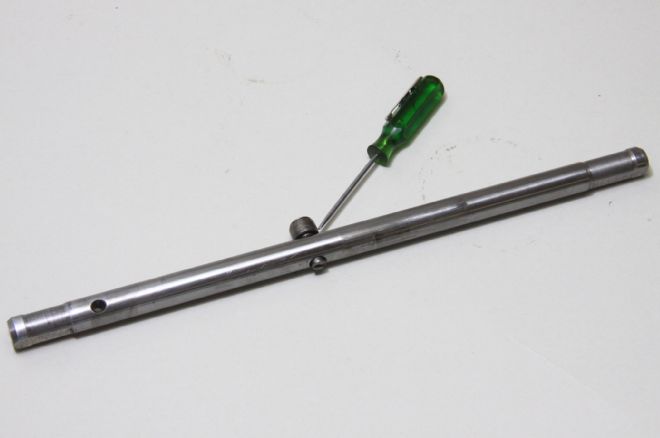
12. The T-5’s shift rail has four jobs to do. It connects the shifter to all shifter forks, which moves each gear cluster into the appropriate gear. The shifter rail has this Fifth/Reverse lever pin/roller assembly. It must be serviceable and free of extreme wear. Shift rail contact surfaces should be free from scoring and irregular wear.
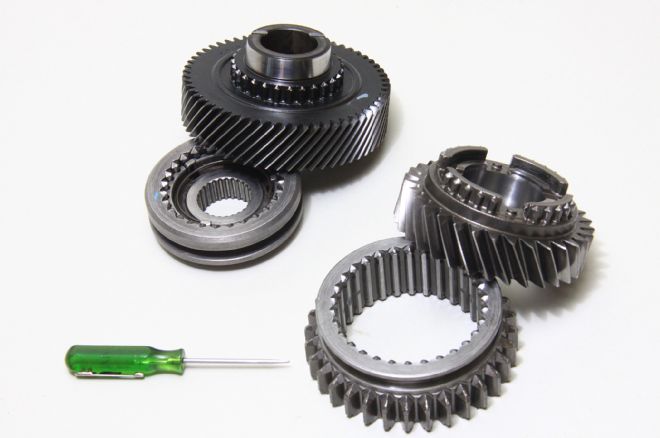
13. Coffey stresses close examination of gear teeth and synchronizers for damage and excessive wear. Look at these items with a magnifying glass for even the smallest imperfection, which can cause shift problems and noise. The reverse slider has minute gear tooth damage, which is easily overlooked during a rebuild.
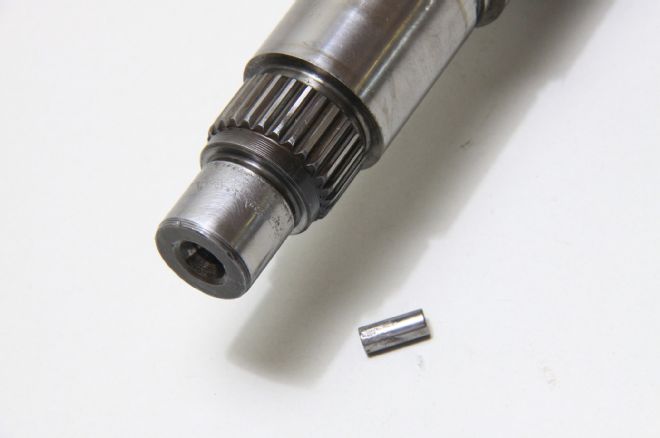
14. Coffey stresses close examination of gear teeth and synchronizers for damage and excessive wear. Look at these items with a magnifying glass for even the smallest imperfection, which can cause shift problems and noise. The reverse slider has minute gear tooth damage, which is easily overlooked during a rebuild.
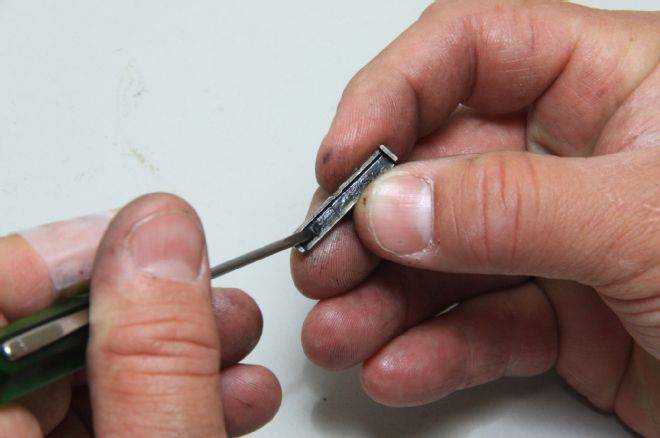
15. Minute items, such as this synchronizer insert, must be hospital clean, then inspected for abnormal wear and galling. If there’s any doubt, replace the insert.
Couture talks about what made the World Class truly world class saying, “No longer were First, Second, and Third gears spinning on a solid output shaft. Needle bearings were installed with each gear ratio to reduce internal friction. The lower counter gears saw tapered bearings to replace the bronze thrust washer. All main shaft synchronizers were fiber-lined steel rings to improve ring friction surface area while overdrive (Fifth gear) remained bronze. Couture adds, “Installing steel synchronizer rings with linings improved two things. These rings don’t stretch and break and the added friction slowing the gear faster allow for higher shift points.
“The stock Ford production 5.0L High Output V-8 World Class T-5 was upgraded with a stronger 3.35:1 gear set by increasing nickel content to produce a harder, stronger gear. Then, Second and Third gear ratios were decreased slightly to channel more torque to the rear wheels. Synchronizer linings on Third and Fourth gear were improved by changing from fiber to carbon-fiber linings to further improve the friction surface resulting in better high-rpm shifts,” Couture reflects. “A longer throw shifter was installed to improve mechanical advantage at the shifter. The speedometer drive gear was changed from a seven- to eight-tooth. The eight-tooth was a step backward when installing lower rear axle ratios greater than 3.55:1 because the driven gear is limited to 21-tooth count. Torque rating jumped to 300 lb-ft.”
Another important improvement in the World Class T-5 came in 1993 in the SVT Cobra Mustang known as the Cobra Spec T-5. The Cobra Spec T-5 was the first T-5 with a front tapered bearing and aluminum/steel front bearing retainer. These Cobra boxes also received a Reverse gear brake and synchro assembly where there had been none before according to Couture. Nearly everything else remained the same, Couture tells us. Torque rating was improved to 310 lb-ft in the Cobra Spec T-5.
When you are shopping for a World Class T-5 core for your Modern Driveline build, keep in mind the bellhousing changed for the SN-95 Mustang for 1994-95 with both the 3.8L Essex V-6 and the 5.0L High Output V-8. The bell became deeper in order to move the shifter further aft in the transmission tunnel. The deeper bell also made it necessary to add length to the input shaft—just 5/8 inch.
Couture comments on the SN-95 T-5, “The neutral safety switch was eliminated on these transmissions because it was no longer needed. The SN-95 5.0L High Output Mustangs received the standard input shaft bearing and aluminum bearing retainer, where the Cobras continued with the tapered or ‘cupped bearing’ input shaft and aluminum/steel front bearing retainer. He adds, torque ratings for both engines and transmissions remained the same as the 1993 Mustang T-5 models. Four-cylinder T-5s were dropped when the Essex V-6 engine came along and replaced with 3.35:1 First gear ratio and either an 0.73 or 0.68 overdrive ratio.” Changing out the input shaft of the 1994-2004 T-5 with 1993 input shaft will enable you to use these transmissions for conversion in 1965-93 Mustangs; as well as other projects because everything else in the World Class T-5 remained the same.
Aftermarket World Class T-5
Where the World Class T-5 story becomes more involved is the aftermarket, which began in the early ’90s. Ford Racing began offering an improved World Class T-5 to its customers known as the T-5Z or 7003Z in 1993. “While the T-5Z is basically a World Class T-5, it has all the nice upgrades, having a 2.95:1 First gear and Cobra pocket bearing does not make it World Class. The T-5Z is a 1993 Cobra T-5 with 2.95:1 First gear set and an 0.63 overdrive. The ‘Z’ has the best of everything—hardened gears, short throw factory shifter, steel front bearing retainer, tapered output shaft bearing, and a seven-tooth speedometer drive gear,” Couture comments enthusiastically. “Best of all the T-5Z has a torque rating of 330 lb-ft based on 100,000 miles of use. The stock T-5Z can handle up to 450 hp with a soft locking clutch when it is not shock loaded like in drag racing.”
Couture tell us the aftermarket offers performance enthusiasts heavy-duty gear sets for the T-5, with some companies claiming 600 lb-ft of torque capacity. “Our experience at Modern Driveline has been different with these gear sets. What makes these gear sets different is the steel alloy and gear shape. Changing to a harder alloy will provide more strength, however, the problem is making sure the gear has some ‘give’ to it. Too hard and gears break. Other ways of increasing torque levels is to take some of the helic out of the gear and make the gear thicker, yet making it more cog like. While this will make the gear stronger, it also makes it much noisier. Many of these aftermarket gear sets are very expensive and require aftermarket main cases and main shaft to get the specified torque ratings these companies claim. By the time the aftermarket gear and supporting parts are purchased, one should consider other options for the same money.”
Couture wants to make sure you know that all World Class T-5 transmissions use ATF (Dextron III) oil, not heavy gear lube or Redline MTL. All non–World Class T-5 transmissions use 50-weight gear oil. The original Ford/Borg-Warner lubrication recommendation back in 1984 was Dextron II. Because Dextron II is no longer available, Modern Driveline and Tremec recommend the 50-weight gear oil. We recommend high-quality synthetic lube because it lasts a long time and over a broader operating temperature range.
Couture adds it is important to change the oil in your transmission based on how you use the vehicle. If the vehicle is your daily driver then changing the oil every two to three years is fine. However, if the transmission witnesses regular track duty and is pushed hard, then lube must be changed every year. “When we rebuild transmissions, we can tell when the oil has been changed often because the parts are much cleaner with less overall wear and tear,” Couture comments. He suggests a magnetic oil drain plug to capture metal fragments that come from use. This coupled with regular lube changes will yield longer transmission life.
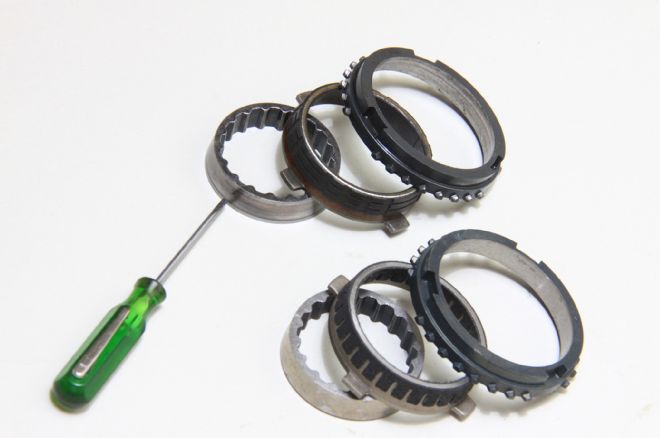
16. Although synchronizers and rings can be reused, it is always suggested you replace them during a rebuild. This helps eliminate any weaknesses and enhances longevity. The above synchronizer assembly shows signs of excessive wear and must be replaced.
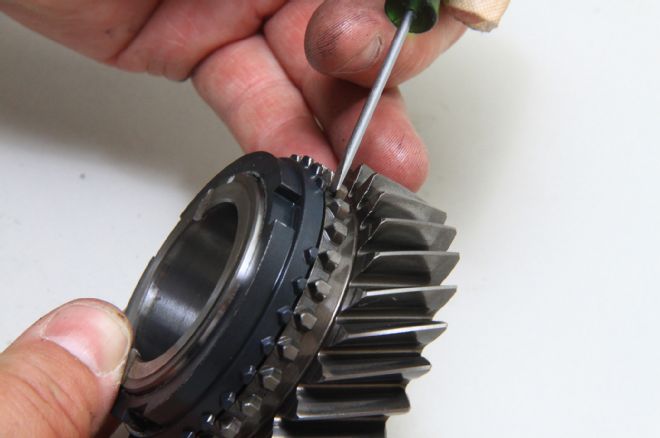
17. Close inspection of this synchronizer shows slight tooth damage, which is not acceptable for a return to service. No matter how minor a flaw may seem, it will cause driveability issues if reused.
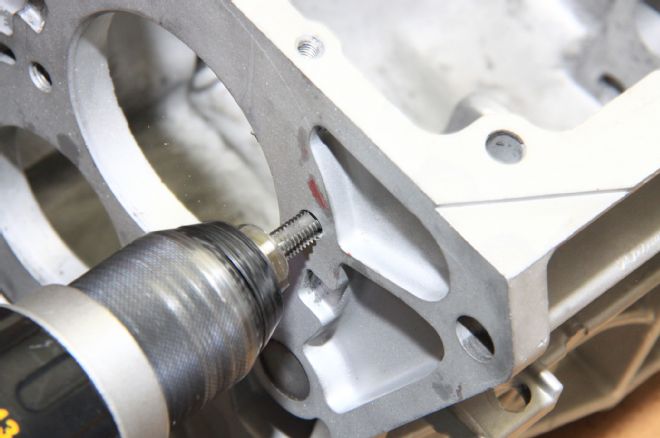
18. All Modern Driveline T-5 rebuilds are virtually new transmissions. Each and every part gets its threads chased to ensure accurate torque measurement during assembly. You should do this on your home workbench if you decide to rebuild a T-5 yourself.
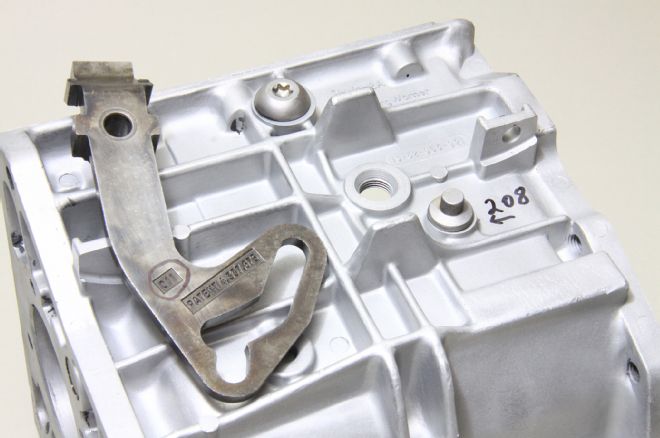
19. Here’s the Fifth/Reverse shift lever, which is closely inspected for abnormal wear. Most of the time, this guy is suitable for a return to service because it has one of the easiest jobs in the transmission. It gives us Fifth gear (overdrive) and Reverse gear.
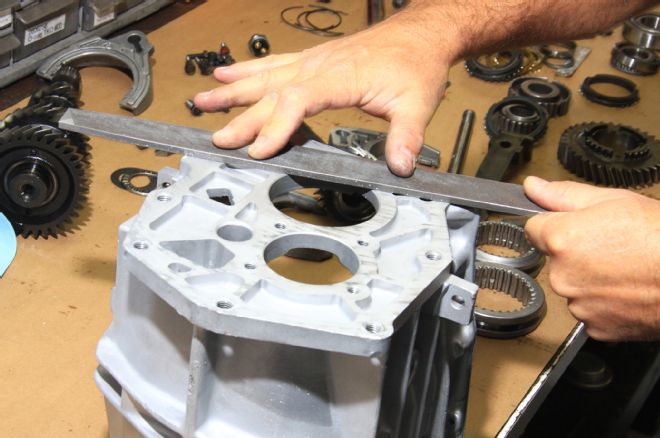
20. Modern Driveline dresses all T-5 casting mating surfaces to ensure a perfect marriage and leak resistance. Irregular surfaces will leak regardless of how much gasket/sealer you use. Surfaces need to be true to where a gasket/sealer will provide a perfect seal.
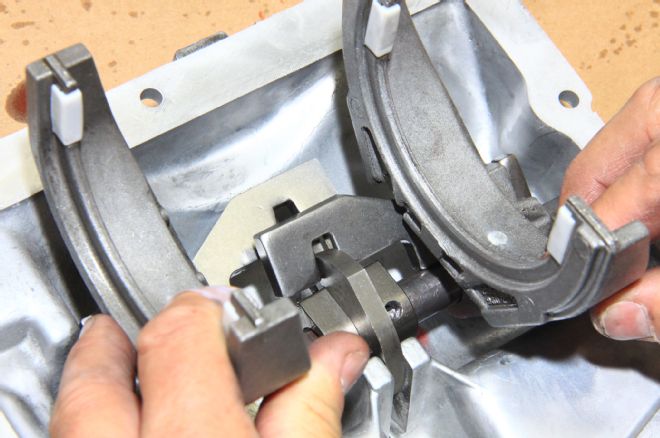
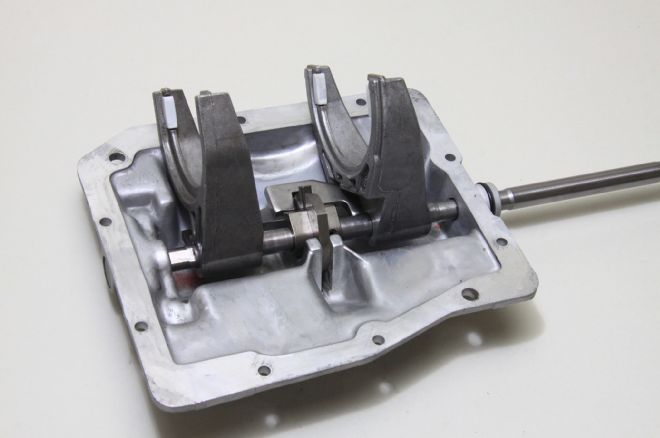
21-22.The T-5’s top cover assembly includes the shift rail and forks. Each of these components and the cover should be checked for damage and excessive wear. Assembly is something on the order of a jigsaw puzzle. The shift rail is inserted first, with each fork and selector detent plates being fitted as the rail is inserted.
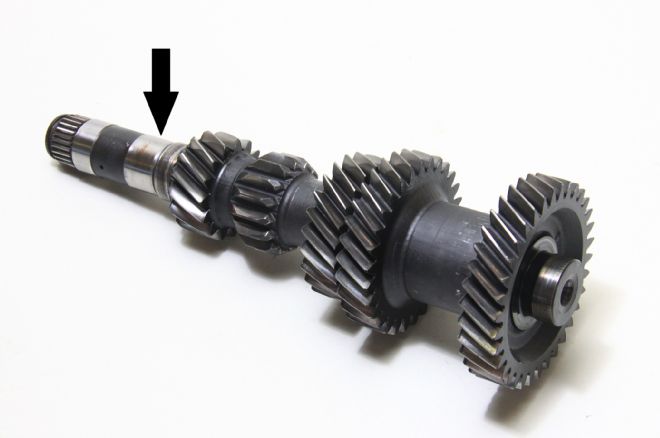
23. Here’s the countershaft, which works hand-in-hand with the gears on the main shaft assembly (output and input shafts) to affect gear ratio and mechanical advantage. As with other transmission components, the countershaft must be inspected closely for damage and abnormal wear. Even minor damage will cause noise and performance issues. If you look at bearing mating surfaces of this World Class T-5 countershaft, there are wear issues. Gear teeth appear free of damage and abnormal wear.
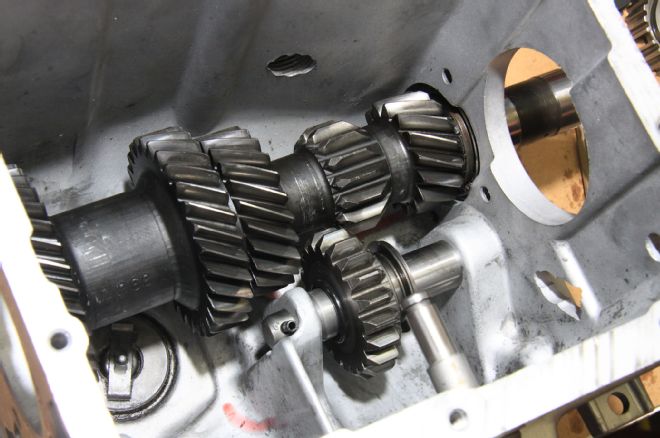
24. Here’s the countershaft installed along with the Reverse idler. These are the first items to go into T-5 assembly.
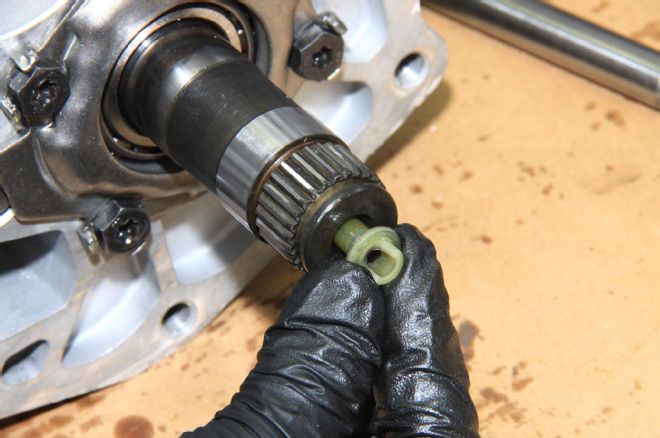
25. Although it is easy to forget, never forget this nylon oiling funnel, which inserts into the output shaft as shown at the Fifth gear/overdrive unit in the extension housing.
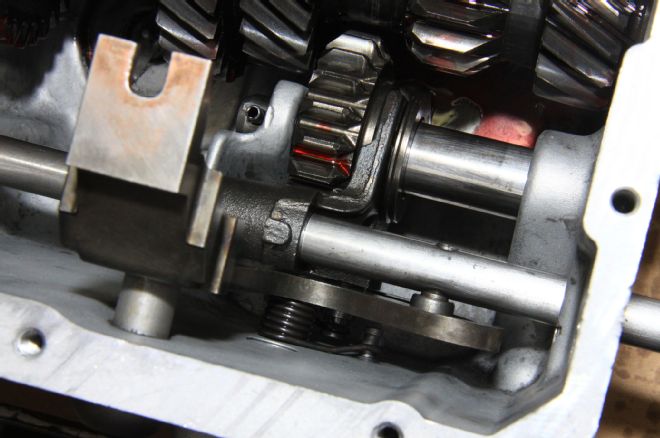
26. Here’s the Reverse idler and Fifth/Reverse shift lever assembled. You can see here where the shift rail roller/pin ties into the Fifth/Reverse shift lever.
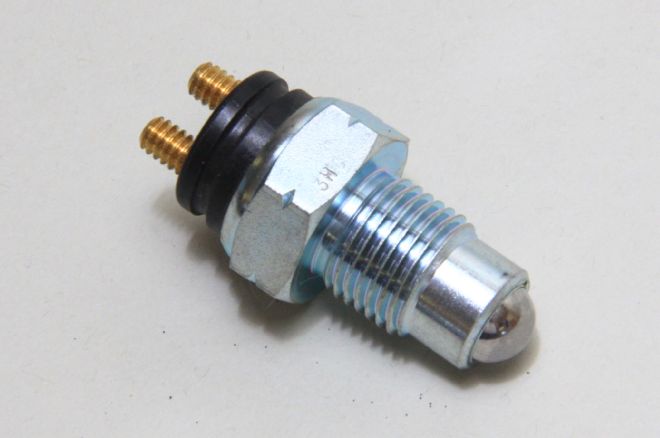
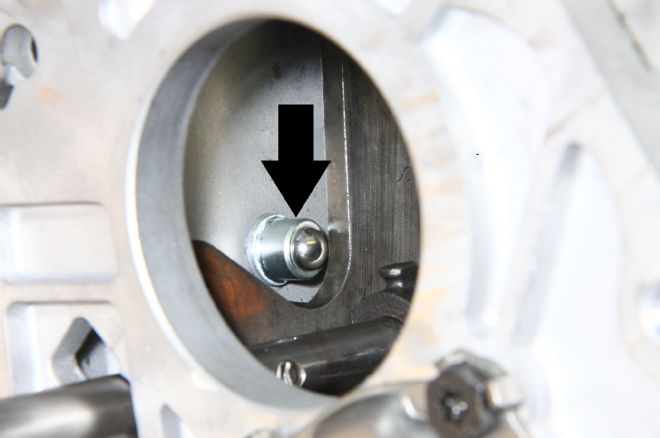
27-28. Here’s the T-5’s backup light switch, which is activated by the Fifth/Reverse shift lever when you shift into reverse gear. At the tip inside is a roller ball that rides the shift lever, closing switch contacts inside.
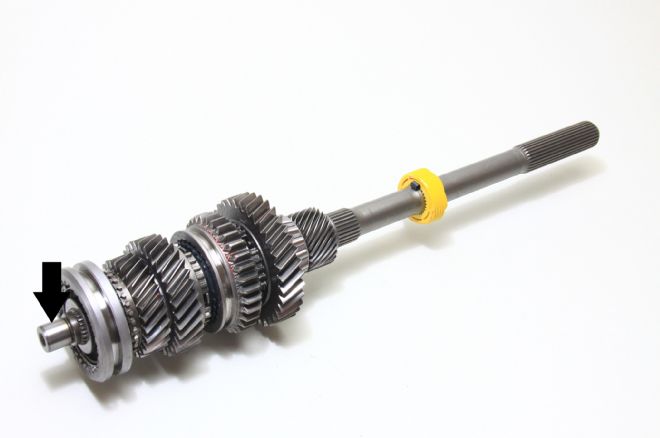
29. This is the World Class T-5’s output shaft assembly complete with gears, bearings, synchronizers, and speedometer drive gear. The input shaft (not pictured here) ties into the output shaft once the output shaft is installed. Needle bearings and input shaft ride the output shaft pilot (arrow), which inserts into the input shaft.
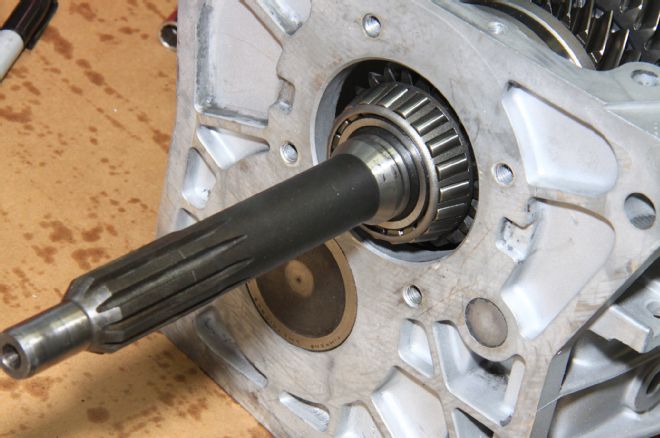

30-31. The T-5’s input shaft has this bearing pocket, which is home to 15 needle bearings that provide support at the output shaft pilot. Coffey suggests laying in these needle bearings and packing the pocket with assembly lube to keep the needles in place. The input shaft is then carefully inserted into the main case and seated on the output shaft as shown. That front bearing retainer follows.
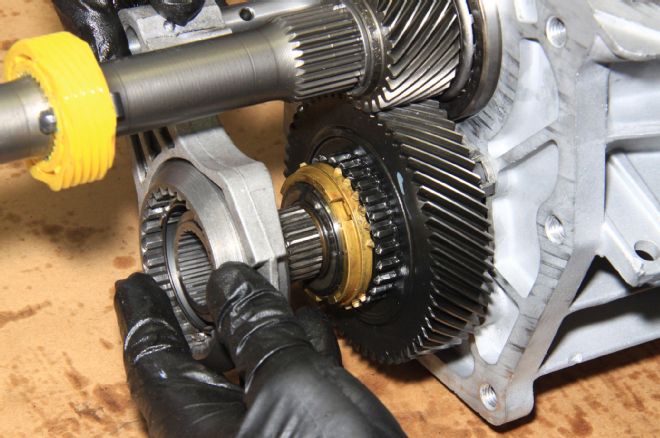
32. The Fifth gear (overdrive) fork, which is housed in the extension housing, is installed and seated on the synchronizer and Fifth gear drive assembly.
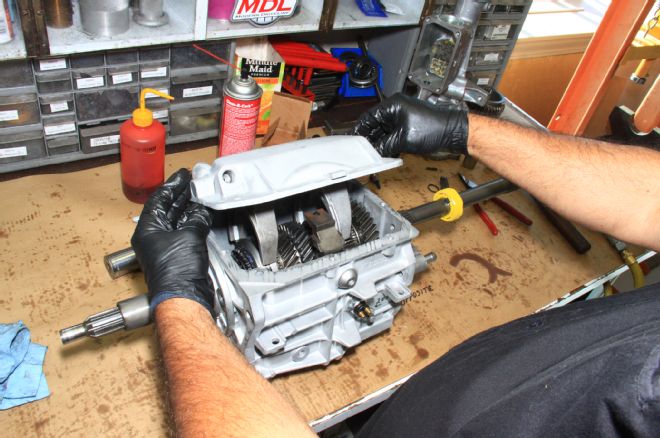
33. The top cover assembly is carefully installed slipping 1-2 and 3-4 shifter forks onto 1-2 and 3-4 synchronizers as shown. Coffey suggests the use of Permatex’s “The Right Stuff” for your T-5 build, because it seals better than anything else and is guaranteed not to leak. Leak prevention also comes from perfecting mating surfaces as shown earlier.
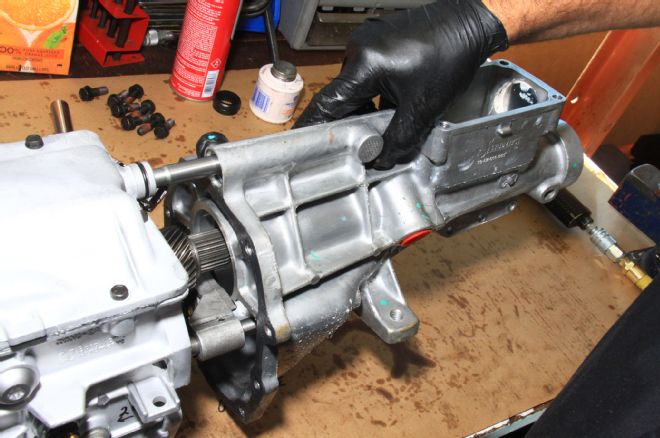
34. The extension housing is slipped into place, paying close attention to the shift rail and mating surfaces. Note the use of “The Right Stuff” between the extension housing and main case.
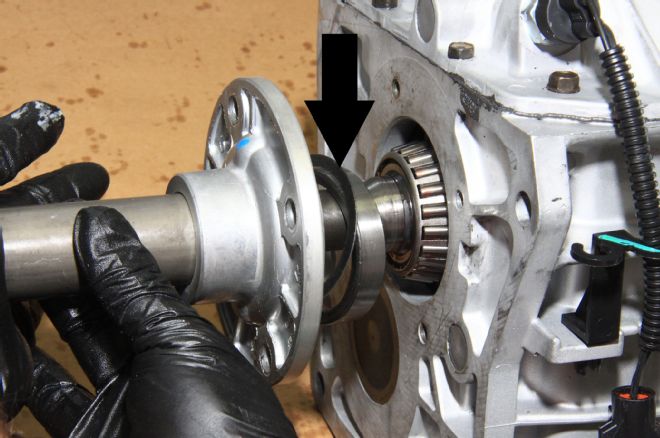
35. The front bearing retainer is installed next, keeping input shaft endplay in mind. Endplay is controlled via a shim or shims (arrow). A tapered roller bearing carries the input shaft load.